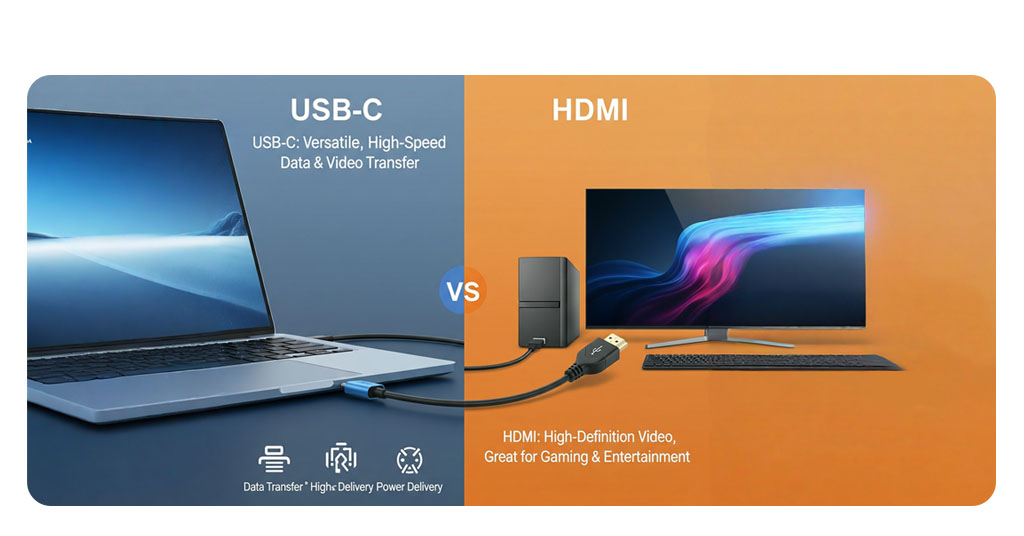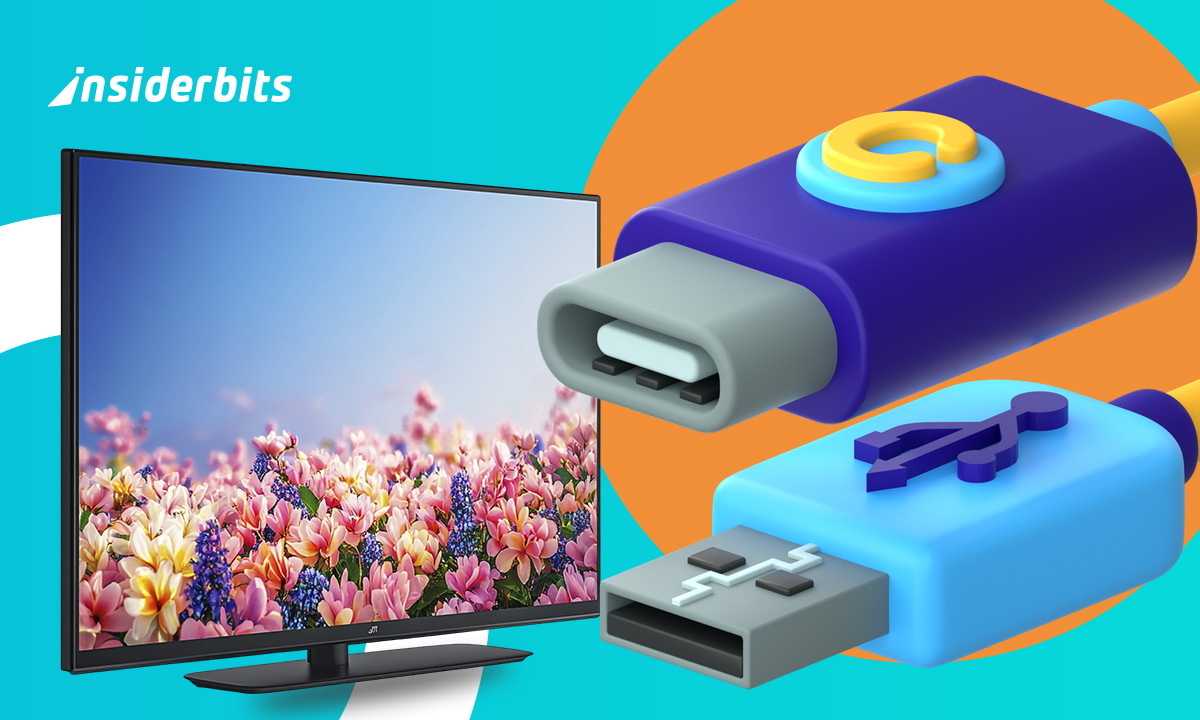Does the back of your TV look like a spaghetti junction of cables even on a good day? HDMI here, power there, maybe some ancient USB-A ports that haven’t been relevant since 2015. Enter USB-C, the sleek, reversible connector that’s finally making its way to modern televisions, promising to simplify our setups while making cable management slightly less of a nightmare.
This isn’t just about charging your phone through the TV (though that’s nice). USB-C on TVs is now a fundamental shift in how we connect peripherals, stream content, and even power devices. Let’s talk about what this actually means for your living room setup—the good, the bad, and the “why isn’t this working?” moments you’ll inevitably face.
- Charging Your iPhone 15: Apple’s Recommendations for Safe and Efficient USB-C Cables
- Wi-Fi Without ISP: Guide to Connectivity
- Comment regarder la télévision internationale sur votre téléphone
Why USB-C on TVs is a game-changer
The inclusion of USB-C ports on newer TV models solves several headaches we didn’t even realize we had:
- One cable to rule them all: charge devices while mirroring their screens—no more hunting for spare outlets;
- Goodbye HDMI? Many USB-C ports support DisplayPort Alt Mode, delivering 4K/120Hz signals without needing separate HDMI cables;
- Power where you need it: with up to 100W Power Delivery, some TVs can now power laptops or tablets directly;
- Docking station potential: connect hubs to transform your TV into a workstation with peripherals.
As highlighted in ZDNet’s TV superpowers article, these ports often do more than manufacturers advertise.
How it simplifies peripheral connections
Gone are the days of needing three different cables for one device. Here’s what becomes possible:
Bye-bye, casting frustrations
No more yelling at your TV because your phone refuses to connect via Miracast or AirPlay. With USB-C, you can:
- Plug in your phone or tablet and instantly mirror your screen in full resolution—no compression, no lag, no Wi-Fi interference;
- Charge your device simultaneously, so your movie night doesn’t get cut short by a dead battery;
- Avoid the dreaded “device not found” errors that make casting feel like black magic.
This makes our phone-to-TV guide almost too easy—just plug in and go.
Gaming laptops finally play nice with TVs
HDMI ports on gaming laptops are disappearing faster than headphone jacks, leaving USB-C as the only viable option. The good news? Modern USB-C on TVs handle this beautifully:
- Single-cable simplicity: no more juggling power adapters and HDMI dongles—just one cable for video, audio, et charging (if your TV supports enough power delivery);
- Higher refresh rates: unlike finicky wireless solutions, USB-C can deliver 4K/120Hz or even 8K/60Hz without compression;
- G-Sync/FreeSync support: some high-end TVs now recognize gaming laptop signals and adjust refresh rates dynamically.
Turn your TV into a true computer monitor
Working from your couch just got a lot more viable:
- Plug-and-play productivity: USB-C carries video, audio, et data, so you can connect peripherals through a hub (keyboard, mouse, external drives);
- No more resolution headaches: unlike HDMI, which sometimes defaults to wonky overscan settings, USB-C often negotiates the correct resolution automatically;
- One-touch switching: some Samsung/LG models detect a USB-C computer connection and instantly switch to a low-latency “PC mode.”
Power your peripherals without extra adapters
Why waste outlets when your TV can do the job?
- Soundbars & streaming sticks: many modern models can be powered directly from a TV’s USB-C port (if it delivers enough juice);
- Webcams & mics: turn your TV into a giant Zoom screen without extra USB hubs;
- LED bias lighting: No need for a separate power brick—just plug into the TV.
The catch? Not all USB-C ports are equal
Before you toss your HDMI cables in the trash:
- Check power delivery specs: some TVs only provide 15W, which won’t charge a laptop;
- Verify video support: just because it’s USB-C doesn’t mean it supports DisplayPort Alt Mode (looking at you, budget models);
- HDMI still wins for some AV receivers: older sound systems might not play nice with USB-C audio extraction.
Limitations to watch out for (power, bandwidth)
Let’s cut through the marketing fluff—most “USB-C compatible” TVs currently on the market are about as useful as a chocolate teapot.
They’ll have the port, sure, but good luck getting more than 15W of power delivery or 4K/30Hz video out of them.
After testing dozens of models, these are the only 2025 TVs that actually deliver proper USB-C functionality worth your attention (and money).
TVs with USB‑C you can actually buy now
Samsung Neo QLED 8K Series – The (almost) complete package
Available in 65-inch, 75-inchet 85-inch variants, Samsung’s flagship QLEDs finally get USB-C right:
- 45W Power Delivery: enough to charge most ultrabooks and tablets while in use (though gaming laptops will still need their power bricks);
- True DisplayPort Alt Mode: delivers crisp 8K/60Hz or 4K/120Hz signals without compression artifacts;
- Dual-port flexibility: one port handles video while the other powers peripherals or acts as a USB hub;
- Smart Switch detection: automatically adjusts picture settings when a computer connects.
The catch? You’re paying $3,000+ for the privilege. But considering these replace the need for a separate docking station and HDMI cables, it’s almost justifiable for power users. Almost.

LG OLED Flex – the gamer’s choice
While not yet available on Amazon, LG’s 2025 OLED Flex series brings:
- Full 100W USB-C Power Delivery: finally enough juice for high-end laptops;
- 240Hz refresh rate support: making it the first TV that hardcore gamers might prefer over dedicated monitors;
- Auto-resolution switching: no more fiddling with display settings when swapping between work and play.
Downside: only one USB-C port, because LG apparently thinks we still enjoy cable juggling.
Sony Bravia XR – the creative pro’s dark horse
Sony’s 2025 refresh includes something revolutionary – a USB-C port that actually:
- Supports Thunderbolt 4 for connecting professional cameras and storage;
- Delivers 10-bit 4:4:4 color for photo/video editing;
- Features low-latency mode that actually works for digital art.
Reality check: you’ll need to sell a kidney for the 85″ model, but at least your Wacom tablet will work flawlessly.
For those not ready to drop several mortgage payments on a new TV, the Reddit hardware community has compiled a shockingly effective list of USB-C to HDMI adapters that work with older TVs.
Our favorite? The $25 Cable Matters adapter that somehow delivers 4K/60Hz without the usual handshake issues.
The bottom line
The USB-C TV revolution is happening – just at the typical snail’s pace of the home entertainment industry.
If you’re buying a TV today and care about future-proofing, make sure those USB-C ports actually support video and decent power delivery. Otherwise, you’re just getting a very expensive phone charger.





